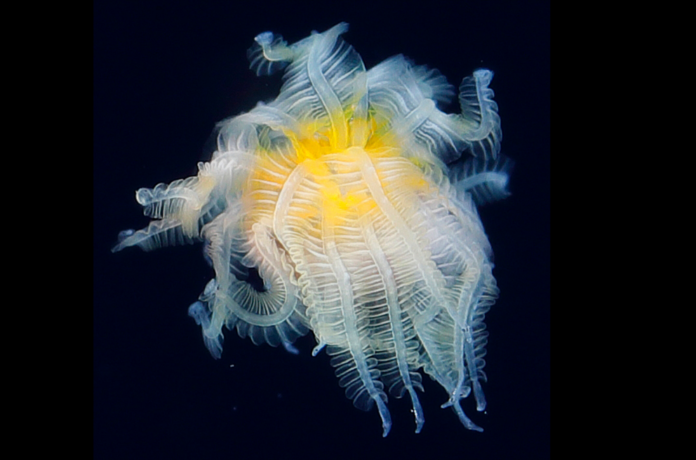‘Mind-boggling’ sea creature spotted off Japan has finally been identified
Two forms of a parasite cooperate to make this swimming mass of larvae.
Tiny, flittering swimmer wasn’t a worm, a mollusk, or a crustacean. What was it?
When Ryo Minemizu, a professional underwater photographer, posted photos of an elegant ladybug-size flittering creature off Okinawa, Japan, in 2018, biologists were baffled. It wasn’t a worm, a mollusk, or a crustacean. What was it? No one knew.
One of those intrigued was Igor Adameyko, a developmental neurobiologist at the Medical University of Vienna. (A fellow enthusiast of marine biology, he spotted the pictures on Instagram, where he has his own account dedicated to marine zooplankton.) Adameyko asked Minemizu whether he had taken a specimen, and, if so, whether he might share it. Not long after, a package arrived at the Karolinska Institute, where Adameyko also works.
Inside was a vial containing the specimen, no bigger than a pea. As Adameyko carefully dissected it, he noticed billowy outer parts, which Minemizu’s footage captured propelling the strange creature, attached to the flat side of a brown hemisphere. They were like “snake hair on the Gorgon’s head,” Adameyko and colleagues report today in Current Biology.
At first, Adameyko thought they were appendages, but looking closer, he noticed it wasn’t a single creature, but many individual organisms, each just a few millimeters long. There were 20 of these swimmers—dubbed “sailors” by Adameyko—in total.
The hemisphere they were all attached to was even weirder. It was essentially a glob of hundreds of sperm-shaped organisms with heads about the size of a pencil point and tails much thinner than a human hair. The tails were tangled together in a center knot, with heads all pointed outward. There are fewer passengers at the top, where the sailors hold on, which may have flattened that side of the spherical mass.
Still, the bizarre conglomerate creature’s identity eluded Adameyko. He consulted other experts, but no one could solve the mystery behind these tiny creatures. It was “absolutely mind boggling,” Adameyko recalls.
With his training in neuroimmunology, Adameyko tried staining the organisms with various antibodies to better reveal their internal anatomy. This helped, some. The pattern of cells in the nervous system suggested the animals belong to a vast group called the lophotrochozoans, which includes mollusks, corallike animals called bryozoans, brachiopods, and flatworms. At this stage, co-authors Darya Krupenko and Aleksei Miroliubov, invertebrate zoologists at Saint Petersburg University, suspected this enigmatic conglomerate might be a parasite.
Next, the team turned to DNA. This was a challenge because the specimen had been preserved for too long in formalin, which destroys genetic material. But using techniques developed to recover badly degraded ancient DNA, the scientists at last put a family name to this mystery swimmer: It belonged to a group of parasitic flatworms called digenean flukes.
Digenean flukes are part of a large and diverse group of parasites known as trematodes. Adults live inside a vertebrate host—fish, cats, or people, for example—and then release eggs into the environment. Some flukes have evolved a behavior in which the larvae join into shapes that mimic small organisms. In doing so, they entice a fish to eat the larvae, so they can continue their life cycle inside the host.
Two forms of a parasite cooperate to make this swimming mass of larvae.
What’s interesting about this new digenean parasite is that the larvae cooperate using two different forms. The DNA confirmed that both the sailors and tiny passengers inside the hemisphere belong to the same species. These passengers, it seems, act as the infectious agents, waiting to infiltrate the gills or intestines of a fish that swallows them. The sailors, meanwhile, do the hard work of moving the blob through the water—but in sacrifice their own opportunities to reproduce.
This phenomenon, in which one member of a species forgoes its own chance to reproduce so that another can, is called kin selection. And this, says Robert Poulin, a parasitologist at the University of Otago who was not involved, is “a really cool case of kin selection pushed to the extreme.”
Scientists have studied the phenomenon in other kinds of trematode parasites while they are living inside their hosts. The “remarkable” new study shows that this division of labor happens in free-living larval forms as well, says Ryan Hechinger, a marine biologist at the Scripps Institution of Oceanography. “This finding highlights that trematodes are unique among all animal life.”
The discovery also hints that the wider world of digenean trematodes may be even stranger than thought. More than 20,000 species have been discovered as adult worms living inside vertebrates, but their juvenile larval forms are unknown, Poulin says. “Some of the most fascinating aspects of these parasites’ biology, and some of their most striking adaptations, may be found in their yet-to-be-discovered juvenile stages.”
For the strange Medusa’s head in his lab, Adameyko would like to learn more about how its component larvae decide to cooperate and how they control the motion of the colony. The sailors have eye spots that can detect light, which may play a role. He hopes to collaborate with scientists in Okinawa to find more specimens. “These are our night science projects, because we want to have fun in the lab,” he says. “The idea is that there are no limits. And if you want to do something cool, you can.”
doi: 10.1126/science.adl0064

